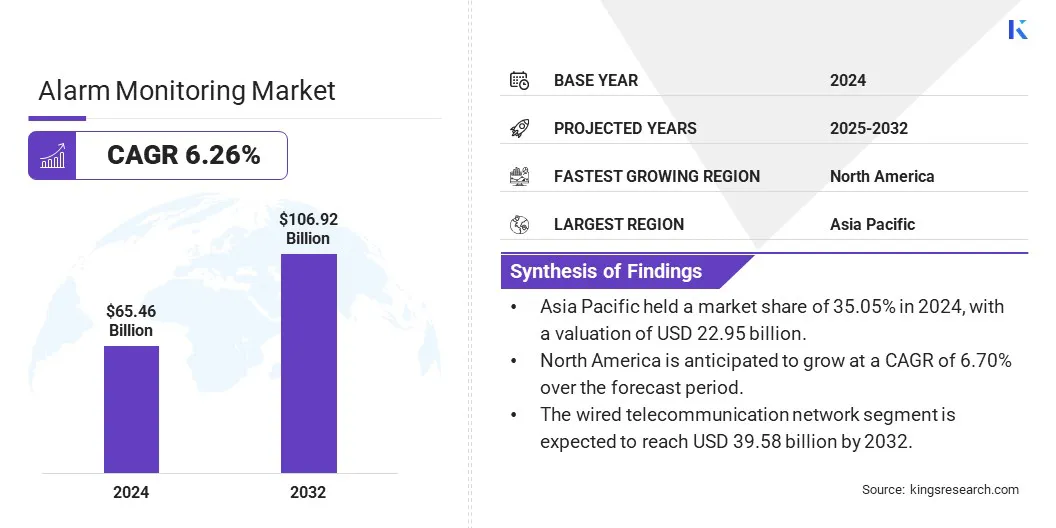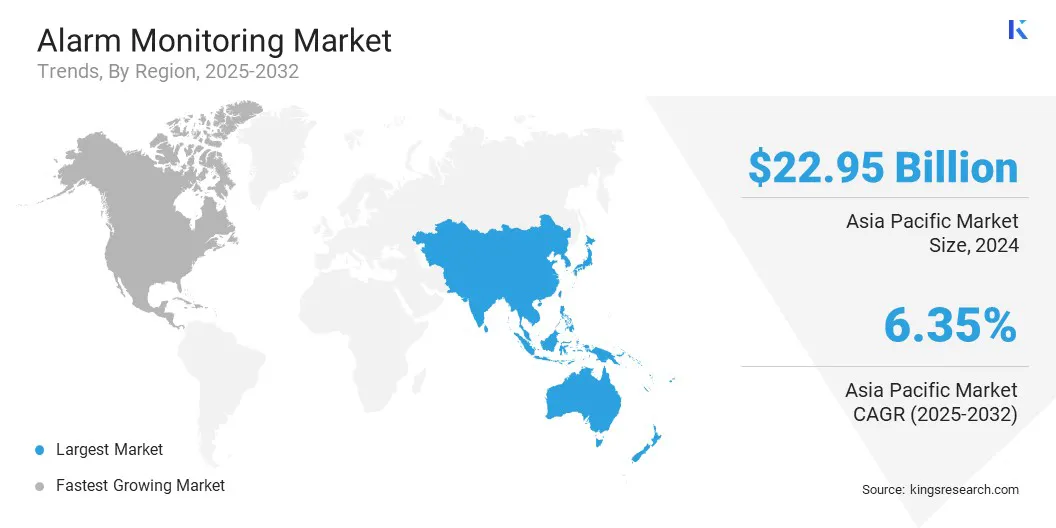Market Definition
The market encompasses services and systems used to detect and report security breaches, fire, medical emergencies, and equipment failures across residential, commercial, and industrial settings. It includes the integration of communication networks, control panels, sensors, and centralized monitoring centers.
The market spans both wired and wireless technologies and covers monitoring services offered by third-party providers and in-house security teams. The report offers a thorough assessment of the main factors driving market expansion, along with detailed regional analysis and the competitive landscape influencing industry dynamics.
Alarm Monitoring Market Overview
The global alarm monitoring market size was valued at USD 65.46 billion in 2024 and is projected to grow from USD 69.35 billion in 2025 to USD 106.92 billion by 2032, exhibiting a CAGR of 6.26% during the forecast period.
Market growth is fueled by rising concerns over property and personal safety across residential, commercial, and industrial sectors. The increasing adoption of automation and smart building technologies is boosting demand for integrated monitoring solutions.
Major companies operating in the alarm monitoring industry are ADT, Vivint, LLC., Securitas Technology, Johnson Controls, Honeywell International Inc., Brinks Home, SimpliSafe, Inc., Frontpoint Security Solutions, LLC, Amazon.com, Inc., Comcast, ABM Industries Incorporated, Securitas Technology, Monitronics, Guardian Protection, and Digital Fire and Security Services.
The shift toward interconnected, smart environments is facilitating integration between monitoring systems and broader building management platforms. The emergence of mobile-based applications and remote access features is reshaping user interaction with monitoring services.
Additionally, evolving service models, including customizable and on-demand monitoring plans, are offering greater flexibility to end users and supporting wider adoption.
- In April 2025, eufy introduced its first professional monitoring security system, ExpertSecure. The system combines Local AI technology and live surveillance experts, and eufy was selected Rapid Response Monitoring to provide 24/7 professional monitoring services for the system.

Key Highlights
- The alarm monitoring market size was valued at USD 65.46 billion in 2024.
- The market is projected to grow at a CAGR of 6.26% from 2025 to 2032.
- Asia Pacific held a market share of 35.05% in 2024, with a valuation of USD 22.95 billion.
- The software segment garnered USD 24.68 billion in revenue in 2024.
- The wired telecommunication network segment is expected to reach USD 39.58 billion by 2032.
- The vehicle segment is expected to reach USD 38.63 billion by 2032.
- North America is anticipated to grow at a CAGR of 6.70% over the forecast period.
Market Driver
Integration of Alarm Monitoring Systems in Smart Home Technology
The market is experiencing significant growth, mainly due to the increasing adoption of smart home technology. As consumers increasinglyuse interconnected devices such as smart cameras, motion sensors, and door/window sensors, demand for integrated alarm monitoring systems is rising.
These systems allow homeowners to receive real-time alerts and remotely manage their security devices, enhancing convenience and safety.
The ability to monitor and control alarm systems from a smartphone or other connected devices is highlighting the need for advanced, integrated solutions that can provide more comprehensive and immediate protection. This shift toward smart home automation is reshaping the alarm monitoring landscape.
- In May 2025, Arlo Technologies, Inc. launched Arlo Secure 6, a new version of its smart home security subscription service. The service features AI-powered innovations, including fire detection, advanced audio detection, and video search capabilities, offering users enhanced insights and real-time alerts to improve home security.
Market Challenge
Rising Cybersecurity Risks
A significant challenge hampering the expansion of the alarm monitoring market is the increasing cybersecurity risks associated with connected alarm systems. As alarm monitoring systems become more interconnected with IoT devices and networks, their vulnerability to cyberattacks, including hacking and data breaches, increases.
These security vulnerabilities can compromise the integrity of monitoring systems, risking customer data and potentially disabling alarm functionality during critical moments.
This challenge can be mitigated through the implementation of robust cybersecurity measures, including encryption, multi-factor authentication, and regular security updates to safeguard against unauthorized access and data breaches. In response, alarm monitoring companies are increasingly integrating advanced cybersecurity protocols to safeguard system security and data integrity.
Market Trend
AI and ML Integration in Alarm Monitoring Systems
A key trend in the market is the integration of artificial intelligence (AI) and machine learning (ML) technologies. These innovations are being increasingly adopted to enhance the accuracy and efficiency of alarm systems by significantly reducing false alarms and improving response times.
AI-driven systems can analyze alarm events with greater precision, learning from past data to distinguish between genuine threats and false triggers. This leads to faster, more accurate decision-making, improved operational efficiency, and increased reliability of alarm systems across residential and commercial applications.
- In October 2024, Honeywell and Chevron formed a strategic collaboration to develop AI-assisted solutions for refining processes. The partnership focuses on creating advanced alarm management solutions to enhance operator decision-making, improve efficiency, and increase safety within the industrial automation sector.
Alarm Monitoring Market Report Snapshot
|
Segmentation
|
Details
|
|
By Component
|
Hardware, Software, Services
|
|
By Technology
|
Wired Telecommunication Network, Cellular Wireless Network, Wireless Radio Network, IP Network
|
|
By Application
|
Vehicle, Building, Equipment, Environment
|
|
By Region
|
North America: U.S., Canada, Mexico
|
|
Europe: France, UK, Spain, Germany, Italy, Russia, Rest of Europe
|
|
Asia-Pacific: China, Japan, India, Australia, ASEAN, South Korea, Rest of Asia-Pacific
|
|
Middle East & Africa: Turkey, U.A.E., Saudi Arabia, South Africa, Rest of Middle East & Africa
|
|
South America: Brazil, Argentina, Rest of South America
|
Market Segmentation
- By Component (Hardware, Software, and Services): The software segment earned USD 24.68 billion in 2024, mainly due to the rising adoption of advanced analytics and real-time monitoring capabilities.
- By Technology (Wired Telecommunication Network, Cellular Wireless Network, Wireless Radio Network, and IP Network): The wired telecommunication network segment held a share of 37.33% in 2024, fostered by its stability, low latency, and secure data transmission benefits in industrial applications.
- By Application (Vehicle, Building, Equipment, and Environment): The vehicle segment is projected to reach USD 38.63 billion by 2032, owing to growing demand for fleet management and real-time diagnostics in the transportation and logistics sector.
Alarm Monitoring Market Regional Analysis
Based on region, the market has been classified into North America, Europe, Asia Pacific, Middle East & Africa, and South America.

The Asia Pacific alarm monitoring market accounted for a substantial share of 35.05% in 2024, valued at USD 22.95 billion. This dominance is primarily attributed to the rapid urbanization across countries such as China, India, and Southeast Asian nations, leading to increased investments in residential and commercial infrastructure integrated with advanced safety systems.
The proliferation of smart city initiatives and the growing middle-class population have significantly boosted demand for modern security solutions, including intrusion detection and fire alarm systems.
Moreover, the widespread deployment of 5G and fiber-optic networks in countries such as South Korea and Japan has enhanced the reliability and scalability of alarm monitoring services, particularly in high-density urban zones and industrial clusters.
- In October 2024, UL Solutions expanded its smoke detection sensitivity testing capabilities at its Suzhou, China, laboratory. The expansion aims to help smoke detector and smoke alarm manufacturers in China and East Asia meet new certification requirements, supporting innovation in fire safety technology and improving product development efficiency.
The North America alarm monitoring industry is expected to register the fastest CAGR of 6.70% over the forecast period. This growth is propelled by the strong presence of key market players and high consumer adoption of connected home technologies in the U.S. and Canada.
The region’s advanced digital infrastructure and high penetration of IoT-enabled devices have enabled seamless integration of alarm systems with home automation platforms. Additionally, the rising prevalence of property crimes in metropolitan areas has sustained the demand for professionally monitored security solutions.
The commercial sector, particularly retail and healthcare facilities, continues to invest in cloud-based alarm monitoring platforms for real-time threat detection and centralized security management.
Regulatory Frameworks
- In the U.S., alarm monitoring systems are regulated by the National Fire Protection Association (NFPA), which sets standards for installation and monitoring requirements. The Federal Communications Commission (FCC) oversees the communication infrastructure, ensuring compliance with telecommunication regulations.
Competitive Landscape
The alarm monitoring market is characterized by strategic initiatives among key players aimed at enhancing service offerings and operational reach. Companies are prioritizing cloud-based platforms for their scalability, real-time data processing, and improved accessibility, allowing users to monitor and manage systems remotely.
Subscription-based models and customizable service plans are being adopted to meet varied user needs. Moreover, there is a strong emohasis on integrating advanced analytics, remote access capabilities, and robust cybersecurity features.
To stay aligned with evolving demands, providers are ensuring compatibility with smart building and automation systems, enabling seamless integration across security, fire, and environmental monitoring applications.
- In October 2024, SimpliSafe launched its Active Guard Outdoor Protection service, utilizing advanced AI technology and the Outdoor Security Camera Series 2. The service enables real-time engagement with potential intruders and offers two monitoring plans to enhance outdoor security.
List of Key Companies in Alarm Monitoring Market:
- ADT
- Vivint, LLC.
- Securitas Technology
- Johnson Controls
- Honeywell International Inc.
- Brinks Home
- SimpliSafe, Inc.
- Frontpoint Security Solutions, LLC
- Amazon.com, Inc.
- Comcast
- ABM Industries Incorporated
- Securitas Technology
- Monitronics
- Guardian Protection
- Digital Fire and Security Services
Recent Developments (Acquisition/Partnership/Product Launch)
- In February 2025, Rapid Response Monitoring and KEYTH Security partnered with Ubiety Technologies to launch Ubiety Halo, the world’s first downloadable solution integrating insights, security, and smart home features. The collaboration aims to enhance security operations through advanced presence verification, reduce false alarms, and improve customer experience in monitored security services.
- In February 2025, Alarm.com acquired CHeKT, a provider of cloud-based remote video monitoring services. The acquisition enhances Alarm.com’s capabilities in professional video monitoring by integrating CHeKT’s platform with its existing solutions, enabling central stations to deliver proactive video verification and response services across a wide range of security systems.
- In January 2025, Blue Eye launched InSite, an interior remote video monitoring solution that uses real-time video and audio verification to reduce false alarms and enable faster police response, addressing the limitations of traditional motion-based alarm systems.


